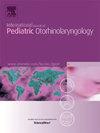用于治疗波兰儿童耳鼻喉疾病的 AMSA® manosonic 雾化吸入器
IF 1.2
4区 医学
Q3 OTORHINOLARYNGOLOGY
International journal of pediatric otorhinolaryngology
Pub Date : 2024-09-20
DOI:10.1016/j.ijporl.2024.112113
引用次数: 0
摘要
简介 AMSA® manosonic 雾化器利用声波振动和气流将药物溶液或悬浮液制成气溶胶。据称,以这种方式产生的气溶胶具有更强的渗透性和给药性。它是在短期超压的情况下给药的,这意味着气雾剂能够通过咽鼓管(ET)渗入中耳:本研究旨在确定 AMSA® manosonic 雾化疗法中用于治疗 2-17 岁儿童常见耳鼻喉疾病的活性物质,并评估 AMSA® manosonic 雾化疗法在这方面的总体效果。通过比较雾化前后的情况,使用以下测试进行评估:(1) 咽鼓管功能测试;(2) 鼓室测量法;(3) 耳镜检查。129 名儿童中包括 56 名女孩和 73 名男孩。他们的年龄在 2 到 17 岁之间,平均年龄为 6.9 岁(SD = 3.0)。其中 6 岁以下儿童 74 名,6 岁以上儿童 55 名。儿童患有以下疾病:(1)慢性中耳炎伴流脓(OME,n = 86);(2)咽鼓管功能障碍(ETD,n = 34);(3)其他疾病(如胆脂瘤、回缩袋)(n = 9)。本研究中的联合用药为布地奈德+氨溴索(含或不含氯化钠)、布地奈德(含或不含氯化钠)、布地奈德+N-乙酰半胱氨酸(含或不含氯化钠)、布地奈德+透明质酸、布地奈德+氨溴索(含透明质酸)、氨溴索(含或不含氯化钠)。80.6%的患者都是这种情况。大多数 OME 和 ETD 患者都接受了 10 次治疗(分别为 79% 和 79.5%),而所有其他疾病患者都接受了 10 次治疗。对鼓室测量结果的分析是按受影响耳朵的数量进行的(而不是按个人)。共有 210 只耳朵进行了完整的鼓室测量(包括治疗前和治疗后),其中包括 142 只患有 OME 的耳朵、54 只患有 ETD 的耳朵和 14 只其他耳朵。经AMSA雾化治疗后,统计顺应性和中耳压力均有明显改善。对所有耳朵进行了耳镜检查。结果显示,155 只耳朵(73.8%)异常,55 只耳朵(26.2%)正常。结论使用 AMSA 人工渗液雾化器似乎是改善儿童慢性疾病(如慢性中耳炎伴渗液和咽鼓管缺损)的有效方法,但前提是患者必须遵从医嘱。最常用的活性物质是布地奈德,与是否使用额外的分泌物/褐质溶解剂无关。本文章由计算机程序翻译,如有差异,请以英文原文为准。
The AMSA® manosonic nebulizer for ENT disease among children in Poland
Introduction
The AMSA® manosonic nebulizer uses acoustic vibration and a flow of air to create an aerosol from a solution or suspension of a drug. The aerosol created this way is claimed to have enhanced penetration and drug delivery. It is administered under short-term overpressure, meaning that the aerosol is able to penetrate into the middle ear through the Eustachian tube (ET).
Purpose
of the study: The aim of this study is to identify the active substances used in AMSA® manosonic nebulization for treating common ENT diseases in children aged 2–17 years and to evaluate the overall effectiveness of AMSA® manosonic nebulization in this context. Assessments were done by comparing conditions before and after nebulization using the following tests: (1) Eustachian tube function test, (2) tympanometry, and (3) otoscopy.
Material and methods
This study was a retrospective study with ethics committee consent. 129 children, comprising 56 girls and 73 boys. They were aged between 2 and 17 years, with a mean age of 6.9 years (SD = 3.0). There were 74 children up to 6 years and 55 children over 6 years of age. Children had the following conditions: (1) chronic otitis media with effusion, OME (n = 86), (2) Eustachian tube dysfunction, ETD (n = 34) (3) Other conditions (e.g. cholesteatoma, retraction pocket), (n = 9). Combination of medicines administered in this study was: Budesonide + ambroxol (with or without NaCl), Budesonide (with or without NaCl), Budesonide + N-acetylcysteine (with or without NaCl), Budesonide + hyaluronic acid, Budesonide + ambroxol (with hyaluronic acid), Ambroxol (with or without NaCl).
Results
The number of nebulizations ordered was between 1 and 20 treatments, but most commonly, pa-tients were given a nebulization series of 10 treatments. This was the case for 80.6 % of the patients. Most patients with OME and ETD had 10 treatments ordered (79 % and 79.5 %, respectively), while all patients with other conditions had 10 treatments. Analysis of the tympanometry results was done in terms of the number of affected ears (not by individual). There were 210 ears with complete tympanometry (both pre and post), including 142 ears with OME, 54 with ETD, and 14 others. Statistically significant changes (improvements) after AMSA nebulizations were found for statistic compliance and middle ear pressure. Otoscopy assessments were done in all ears. The results were abnormal in 155 ears (73.8 %) and normal in 55 ears (26.2 %). After AMSA nebulizations, the number of abnormal results decreased to 117 ears (55.7 %) and normal results were found in 93 ears (44.7 %).
Conclusion
Use of the AMSA manosonic nebulizer appears to be an effective way of improving chronic medical conditions in children – such as chronic otitis media with effusion and Eustachian tube defect – but only if patient compliance can be achieved. The most frequently used active substance was budesonide, irrespective of whether additional secretolic/mucolytic agent was administered.
求助全文
通过发布文献求助,成功后即可免费获取论文全文。
去求助
来源期刊
CiteScore
3.20
自引率
6.70%
发文量
276
审稿时长
62 days
期刊介绍:
The purpose of the International Journal of Pediatric Otorhinolaryngology is to concentrate and disseminate information concerning prevention, cure and care of otorhinolaryngological disorders in infants and children due to developmental, degenerative, infectious, neoplastic, traumatic, social, psychiatric and economic causes. The Journal provides a medium for clinical and basic contributions in all of the areas of pediatric otorhinolaryngology. This includes medical and surgical otology, bronchoesophagology, laryngology, rhinology, diseases of the head and neck, and disorders of communication, including voice, speech and language disorders.

 求助内容:
求助内容: 应助结果提醒方式:
应助结果提醒方式:


